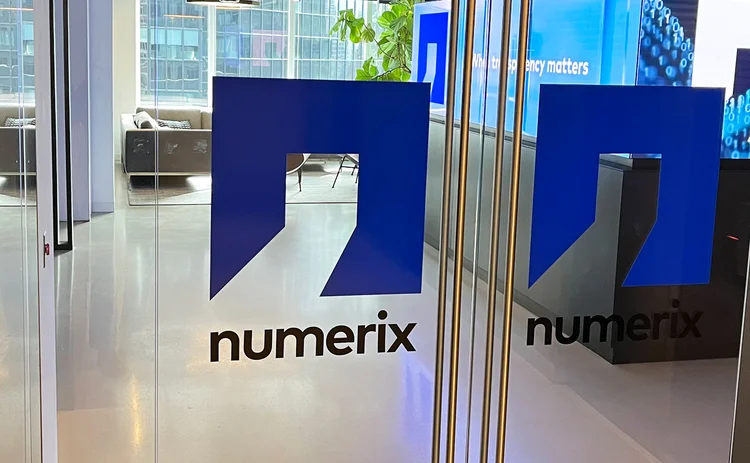
Technology vendor of the year: Numerix
Risk Awards 2025: Fincad and PolyPaths deals added coverage; AAD and cloud refactoring boosted speed

In markets technology, one of the buzz-phrases of recent years has been ‘front-to-risk’ – a gift to the industry from incoming trading book capital rules, which disqualify banks from using their own models if the numbers generated by front-office and risk systems diverge. Regulators want consistency; banks and vendors set out to provide it, and a trend was born.
This goal poses two obvious challenges to vendors with their roots in derivatives pricing. First, they need to cover the whole trading business, not just a slice. Second, they need to go far beyond their reach out into the continuing lifecycle of an instrument, beyond pricing and sensitivities.
Numerix wins this year’s award for the rapid progress it has made on both fronts.
Some of this has been powered by the deals the firm closed since it was acquired by private equity firm GenStar Capital in mid-2022. Acquisitions followed quickly – the purchase of Fincad was announced in April 2023, bringing coverage of bonds, futures and light exotics. PolyPaths followed in August 2023, adding a range of securitised products to the mix.
The immediate priority was to give clients rapid access to this expanded coverage. Instead of trying to squash three pricing libraries into one, Numerix chose to make each of them available via a common API. Different analytics continue to run behind this API, but with a degree of standardisation in the way trades are represented and market data is ingested. It meant clients were able to benefit almost immediately.
“We already have many clients who are – behind the scenes – drawing on multiple offerings from Numerix. So, part of their portfolio is going to PolyPaths and another part to Fincad, and part to the Numerix library,” says Ilja Faerman, head of client solutions for Numerix in Europe.
We now have perfect alignment between front-office valuations and risk valuations – and that’s really important
Ilja Faerman, Numerix
Last month – outside the judging period for these awards – Numerix also announced the acquisition of Kynex, a convertible bond specialist.
In the past, Numerix was always willing to hash together some kind of valuation model to cover a client’s specific needs. Now, it has battle-tested libraries covering a much wider sweep of instruments.
Judges in this year’s Markets Technology Awards – where Numerix was a double-winner – praised the firm as “truly multi-asset” and applauded acquisitions that “have increased value for clients”.
That feeling is palpable within the firm, too. “It’s a huge advantage,” Faerman says of the expanded coverage. “In our market risk solution, we can now cover the entire portfolio, so we don’t need to treat asset- and mortgage-backed securities as some sort of exception – they are fully supported by Numerix analytics.”
For vanilla securities, the change has also been dramatic. In the past, clients often came to the firm with a list of identifiers – Isins or Cusips – and the size of the position, asking for valuations in return, Faerman says. The old Numerix – rooted in the over-the-counter markets – couldn’t work with that information alone.
“Historically, Numerix would say, ‘Oh, but we still need all the information about terms and conditions,’ because we were more on the OTC side. Now, thanks to Fincad and PolyPaths, we also have the security masters, so we can just consume the Isin information, the position size, and then we can source all of the required Ts&Cs data, and perform the valuation using the requisite libraries,” Faerman says.
‘Perfect alignment’
That starts to address the book-coverage challenge for an aspiring front-to-risk vendor. What about handling more of the tasks that link front office and risk teams?
There has been progress here, too. Faerman highlights work on post-trade processing and analysis, taking the software beyond its traditional roots in pricing and sensitivities to encompass tasks such as P&L calculations and trade lifecycle management.
It’s about automating as much of the workflow as possible, making it more efficient
Ilja Faerman, Numerix
In keeping with the expectations of the Fundamental Review of the Trading Book – the industry’s new prudential standards for market risk – Numerix has also ensured front-office and risk calculations are working from the same foundational model. Firms wishing to calculate their own market risk capital requirements under FRTB’s internal models approach must pass a P&L attribution test that looks for discrepancies between valuations used by the front office and those used by risk teams.
“We now have perfect alignment between front-office valuations and risk valuations – and that’s really important,” says Faerman.
This alignment is being used by some banks to help validate IMA and related calculations such as the new standardised approach to credit valuation adjustment, he adds. Currently, only 10 banks are initially expected to apply to use the IMA.
The firm has also been focusing on workflows that sit entirely within the front office – for example, the interaction between salespeople and the desk that calculates and manages the panoply of derivatives valuation adjustments (XVAs). Often, XVA desks are centralised, and end up fielding multiple requests from salespeople around the bank for add-ons to reflect credit, capital, funding and margin valuation adjustments, so they can be incorporated in pricing that goes back to clients.
In many cases, this back-and-forth is done by phone or email. In recent months, Numerix has added an internal request-for-quote function that sales can use to obtain not just add-ons but also a running XVA spread.
“It’s about automating as much of the workflow as possible, making it more efficient,” says Faerman. Two Asia-based clients are using the new RFQ functionality, he adds, with a European client currently reviewing it.
Working the cloud
A third challenge for any vendor in this space is performance, given the huge burden involved in modern, portfolio-level calculations.
Like its peers, Numerix has embraced cloud to give clients the computational headroom they need. In the past year, it has been looking more carefully at what that means – and generating some eye-popping cost reductions.
“If you look at the higher levels of these calculations – the collateral logic, the netting sets and other credit mitigation, the business logic and aggregation – there was often a lack of integration between it and the underlying models. We took it all to the cloud, but in the past few years we’ve spent a lot of time refactoring, streamlining, removing duplicative or unnecessary steps,” says Andrew McClelland, director of quantitative research for Numerix.
The result has been a 20-times reduction in cost on top of the original savings generated by the initial switch to the cloud, he says. McClelland also claims a 10-fold reduction in ‘wall time’ – the amount of time it takes to run a block of code end-to-end, including any hold-ups in the process.
To get to the point we’re at now, where we can cover the portfolio of a big bank – you know, 15,000 OTC trades or so – that was a multi-year exercise
Andrew McClelland, Numerix
The benefits have been unlocked by what McClelland calls a “dance between traditional quants and technologists”.
“If you take a computational algorithm, and just translate that into a big, distributed-compute environment, you lose some of what a quant does – sitting there on a laptop, chiselling out a low-level algorithm and thinking about how to manage memory and do things efficiently. There’s a lot you can do, to trim the number of calibrations, to parallelise at the lowest level possible, to just collapse as much as possible,” he says.
At Numerix, the end result of all this has been a “jointly owned” XVA engine, he adds – a departure from the original approach, where a technical specification might have been developed by the quant team, and then “thrown over the fence” for developers to implement.
“It’s not like ‘this is my problem, and this is your problem’ anymore. It’s our problem, and we’re going to sit here and we’re going to stay on this until this thing does what we’re expecting it to do,” says McClelland.
Further benefits in terms of speed have been delivered through the use of adjoint algorithmic differentiation (AAD) – a technique that started to be explored by quants around a decade ago, because it allows calculations to be run simultaneously, rather than sequentially.
It may look as though Numerix is late to this party, but McClelland says the firm started working on it pre-pandemic – “It just takes a long time to retrofit a large calculation engine with support for AAD across all models and calculation types. To get to the point we’re at now, where we can cover the portfolio of a big bank and produce both present value and XVA sensitivities using AAD – you know, 15,000 OTC trades or so – that was a multi-year exercise,” he says.
But it’s been worthwhile. In back-allocation exercises – where the software is being used to break down a portfolio CVA number and attribute it to individual trades – the AAD-powered system delivered results 15 times faster than the conventional equivalent, says McClelland.
Only users who have a paid subscription or are part of a corporate subscription are able to print or copy content.
To access these options, along with all other subscription benefits, please contact info@risk.net or view our subscription options here: http://subscriptions.risk.net/subscribe
You are currently unable to print this content. Please contact info@risk.net to find out more.
You are currently unable to copy this content. Please contact info@risk.net to find out more.
Copyright Infopro Digital Limited. All rights reserved.
As outlined in our terms and conditions, https://www.infopro-digital.com/terms-and-conditions/subscriptions/ (point 2.4), printing is limited to a single copy.
If you would like to purchase additional rights please email info@risk.net
Copyright Infopro Digital Limited. All rights reserved.
You may share this content using our article tools. As outlined in our terms and conditions, https://www.infopro-digital.com/terms-and-conditions/subscriptions/ (clause 2.4), an Authorised User may only make one copy of the materials for their own personal use. You must also comply with the restrictions in clause 2.5.
If you would like to purchase additional rights please email info@risk.net
More on Awards
Market liquidity risk product of the year: Bloomberg
Bringing clarity and defensibility to liquidity risk in a fragmented fixed income market
FRTB (SA) product of the year: Bloomberg
A globally consistent and reliable regulatory standardised approach for FRTB
Best use of cloud: ActiveViam
Redefining high-performance risk analytics in the cloud
Best use of machine learning/AI: ActiveViam
Bringing machine intelligence to real-time risk analytics
Collateral management and optimisation product of the year: CloudMargin
Delivering the modern blueprint for enterprise collateral resilience
Flow market-maker of the year: Citadel Securities
Risk Awards 2026: No financing; no long-dated swaps? “No distractions,” says Esposito
Pricing and analytics: fixed income – Quantifi
Quantifi delivers high-performance, transparent and adaptable pricing and risk analytics for fixed income and credit markets
Derivatives house of the year: Citi
Risk Awards 2026: Rev up, RWAs down, as US bank gets back on track (with added XiNG and XiP)









